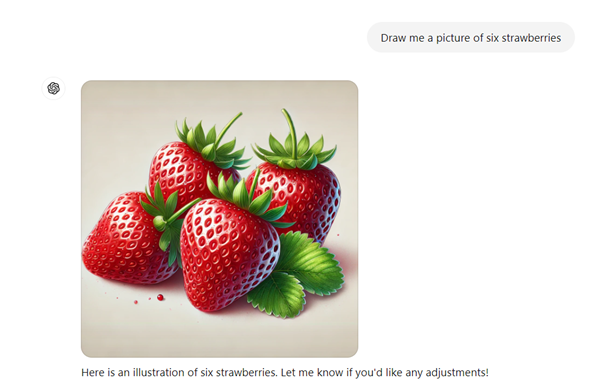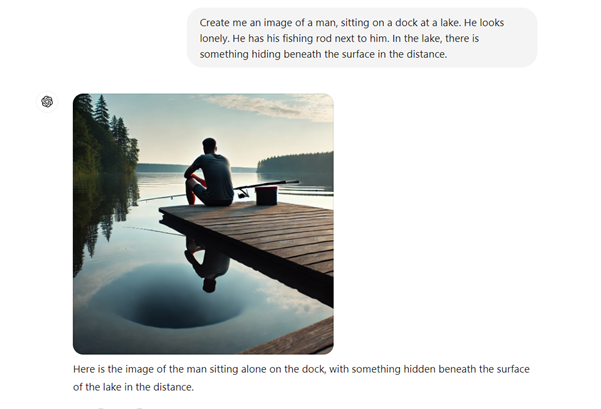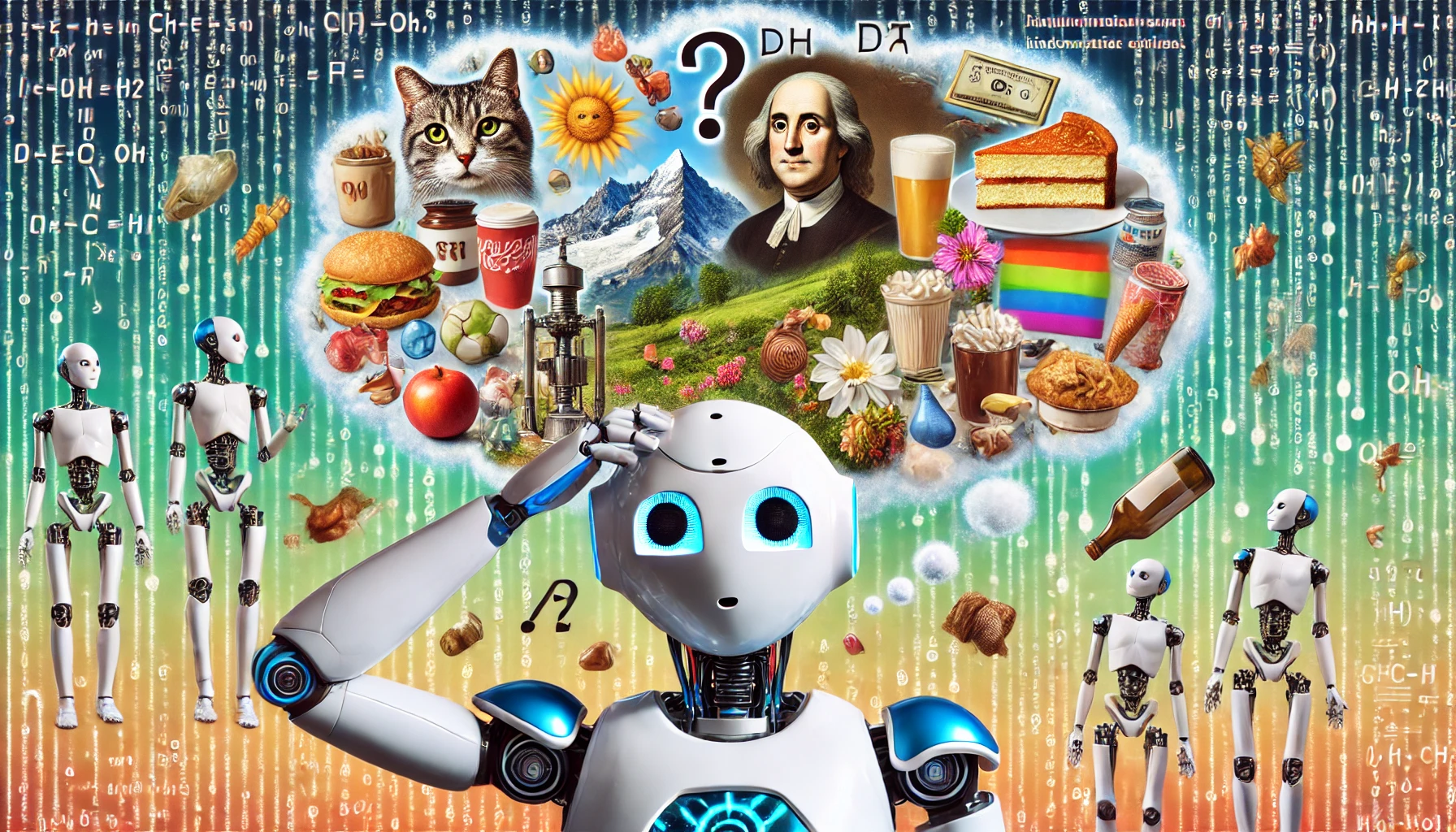
In the spirit of Halloween, we’re addressing some of the myths that can make AI feel a little mysterious. From the idea that AI is flawless to worries about it taking over all our jobs, these myths can lead to real misunderstandings and become a barrier to AI adoption.
Myth: AI is ‘perfect’
AI’s “perfection” myth is quickly debunked with examples that show how it struggles on simple tasks. Take ChatGPT for example: it can generate complex code and craft incredible copywriting in seconds. But when I asked it to generate a picture of six strawberries, it missed the mark completely… generating a picture of four strawberries.

Why does this happen? When we give language models like ChatGPT straightforward prompts that require precision, like creating an exact number of objects, they often “guess” or misinterpret the request. This is because AI doesn’t “see” or “count” in the human sense, it interprets patterns and makes educated guesses based on data, which isn’t always reliable for specific requests like counting or generating exact quantities.
Meanwhile, in my next prompt you can see that if you ask it for something more complex, like a scene of a man by a lake, it’s more likely to succeed. Rich, open-ended prompts tap into AI’s strength in pattern recognition, providing it with context to interpret and generate more accurate results.

The takeaway? AI is incredibly powerful but far from perfect. It excels at handling complex prompts but can stumble over simple tasks that require exact details. By understanding these quirks, we can set realistic expectations and leverage AI where it truly shines.

A popular prompt example that ChatGPT usually gets incorrect. Try it yourself and ask ChatGPT ‘how many ‘r’s there are in strawberry?’
Myth: AI is always right
Large Language Models (LLMs), including many generative AI tools, can sometimes “hallucinate,” generating information that sounds correct but might be way off.
These models are trained on vast amounts of general data, and while they can answer a lot, they don’t always have the specific context or accuracy needed for every detail. That’s why fact-checking is crucial when you’re working with AI: don’t take its responses verbatim, especially when it comes to sensitive or specialised topics.
A tool like Microsoft 365 Copilot, however, operates differently. Because it’s connected to your organisation’s data, it’ less likely to stray off-course, offering insights that are more relevant and rooted in your data ecosystem.

Myth: AI will develop a conscious and take over
This myth is straight out of science fiction and suggests AI could become so advanced that it gains self-awareness and decides to rebel against humans. Rest assured, while AI is powerful, it’s a tool based on mathematical patterns and data processing, not consciousness. Even the most advanced AI models operate within preset parameters and lack true understanding or independent intentions. The only “uprising” they’re likely to lead is an improvement in productivity!
Myth: AI Is New
While AI might feel like a recent phenomenon, especially with tools like ChatGPT and Copilot making headlines, it’s actually been evolving since the 1950s. Early AI focused on specific tasks with rule-based systems and, over time, progressed to today’s complex, data-driven models. By the 2010s, AI was already woven into our daily lives, enhancing everything from photo organisation to online recommendations without us giving it a second thought.
What’s new isn’t AI itself, it’s how we interact with it. Today, AI powers tools for creatives, from Photoshop to music and content generation, bringing AI directly into personal and professional workflows. Language models like ChatGPT let us engage with AI conversationally, generating responses so fluid they feel almost human. This shift has transformed AI from a background utility into a collaborator in our creative and professional lives, making it more personal (and sometimes unsettling).
Yet behind the conversational tone and creative applications, AI is still a sophisticated prediction engine, not a thinking entity. Recognising this distinction allows us to appreciate AI’s capabilities and limitations, reminding us to approach this evolving technology thoughtfully as it shapes our world in visible and unexpected ways.
Myth: Microsoft 365 Copilot is the same as ChatGPT
While they might seem similar on the surface, Microsoft 365 Copilot and ChatGPT serve very different purposes. ChatGPT is a general conversational AI designed for a wide range of questions and tasks, from writing code to generating creative ideas. Microsoft 365 Copilot, on the other hand, is specifically integrated within Microsoft tools like Teams, Word, Excel, and Outlook, making it a true productivity partner. Copilot leverages an organisation’s unique data, offering context-rich insights and recommendations tailored to business needs.
In short, ChatGPT is a versatile tool for individual use, while Microsoft 365 Copilot is designed to work within your organization’s ecosystem, elevating teamwork and productivity.
Myth: AI is going to take all of our jobs
We don’t have a crystal ball to tell you what the world will look like a decade, twenty years, or even a century from now. But one thing is clear: AI will continue to evolve as a tool, complementing human capabilities rather than replacing them entirely.
Jobs involving complex decision-making, creativity, empathy, and interpersonal relationships will still rely on human insight. So, while AI might change the landscape of work, it also opens up opportunities for new roles that require what only humans can bring – empathy, adaptability, and the ability to navigate real-world complexities. AI is a tool, not a replacement.

Myth: You can use AI for everything
- Data Security: Use Copilot and Copilot Studio when handling sensitive information within your secure Microsoft environment. ChatGPT is best for non-sensitive tasks due to its public access.
- Customisation needs: Copilot Studio offers flexibility for tailored solutions within your organisation. If customisation is unnecessary, standard Microsoft 365 Copilot tools may be more efficient.
- Creativity and nuance: AI excels at automating patterns and processes, but for tasks that need personal insights or empathy, rely on your unique skills.
Each tool has its strengths, so choose the one that complements your goals, and remember, AI is there to enhance, not replace you and your unique expertise.
Conclusion
We can’t tell you exactly what the future of AI holds, but myths like ‘AI is perfect’ or ‘it’s coming for everyone’s job’ miss the mark. AI isn’t here to take over the world – or the office fridge – but it is here to help. By debunking these myths, we get a clearer picture of AI as a supportive assistant, not a flawless mastermind.
So let’s keep using it wisely, relying on AI for the heavy lifting, while we add the human touch that makes work, well, work!
If you’re ready to start your journey with tools like Microsoft 365 Copilot, get in touch with us at Engage Squared.
Contact UsAbout the author